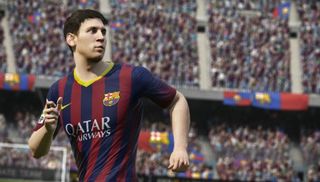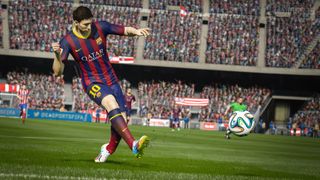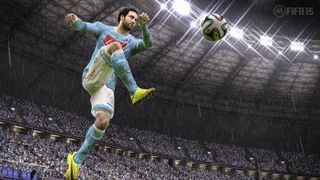
The Venn diagram intersection of 'PC gamers' and 'people who quite like football' were served particularly thin gruel by EA last year, who gave us a vanilla port of the PS3/Xbox 360 game instead of the next-genified version that was released on PS4/Xbox One. Thankfully, if belatedly, that situation will be rectified later this year with the release of FIFA 15. At a recent event in the UK, producer Nick Channon told me that this year's PC game is being built using the same Ignite engine as the next-gen consoles, and performance will be on a par with them. Which means 1080p at 60fps, assuming you've got a capable enough rig.

How capable? You can see the minimum and recommended specs here . “I'm not going to lie—it's going to be a good machine,” said Channon. “We had to make sure that the PC version was high-end, because that's what people seem to want. ” Indeed we do. Although not exactly apologetic about the lack of a next-gen PC version last year, he did offer some explanation.
“We had to bring out a new game on two new consoles,” said Channon. “We didn't have the bandwidth and the time to move it to PC as well… It doesn't just happen. There's some work there. It was just a timing thing.” You can read the rest of our interview with him here .
The fact that 2014 was effectively a fallow year for FIFA on PC means that the improvements found in FIFA 15 are likely to seem even more pronounced if you skipped the next-gen console instalment. Last year's PS4/Xbox One game was well-received by reviewers (hovering around the high 80s on Metacritic), and having had a hands-on with this year's model, I can confirm that even at 50% complete it feels improved across the board. Here's a rundown of the main areas that have received attention…
Improved looks
Of course it's prettier—they always are—but the upgrade seems substantial this time. It feels almost facile to choose the pitch as the standout improvement, but it's the grass that I keep coming back to when I think about FIFA 15. Gone is the perfect green baize of old, replaced by a near photorealistic surface which changes as the match wears on. That's thanks to a new system which records footmarks and sliding challenges. The stipples and scuffs look spot on, and player's kits also get muddied up accordingly.
There are tons of other incidental details too. Like LED advertising hoardings that now animate more like the real things, corner flags which (finally) have actual physical properties, and goal nets which skip off the ground when struck by a particularly fierce shot. All small stuff in isolation, but—taken together—the overall effect is impressive. Player animation has also been given an extensive makeover. They look lithe and leaner, now—more like pro footballers who can't afford to carry around excess weight, rather than the musclebound UFC refugees of previous years. All of which is complemented by a lighting system that's also more natural.

More contextual
Where the push for authenticity gets interesting is in the way the AI-controlled players behave. Whereas in previous games every goal or foul was essentially treated the same, now there's much more focus on what the context of the match is at the time it happens. So a late winner against your local rivals will result in a 10-man pile-on. Equally, if one player keeps hacking down another, (hello Cheik Tioté), then eventually the victim will lose his temper, start moaning to the ref, and so on.
PC Gamer Newsletter
Sign up to get the best content of the week, and great gaming deals, as picked by the editors.
Tracking the relationships between all 22 players is all handled in real-time, which EA says wouldn't have been possible previously. To demonstrate, we're shown Everton's Tim Howard letting a back pass roll straight into his goal from kickoff against Liverpool. Oops. While we aren't treated to his presumably potty-mouthed reaction, we do get to see how his relationship with his teammates instantly deteriorates. These relationships are illustrated in the form of lines (which won't appear in the final version of the game) radiating from Howard to the other players on the pitch. After his mistake, his teammates' all go from white to magenta, indicating they're angry and no longer trust him. Meanwhile, Luis Suarez's mood instantly perks up.

It's important to note that this system is purely cosmetic and won't impact on the players' performance. The team at EA felt that would be too annoying. But what it does mean is that if a striker keeps shanking chances, (hello, Roberto Soldado), his colleagues will become visibly annoyed, throwing their hands in the air or shaking their heads sadly. Again: it might sound like small potatoes, but these little contextual flourishes will help draw players into the narrative of a match. There's some nice club-specific stuff too. At Anfield the fans hold their scarves aloft as they sing You'll Never Walk Alone, while City fans will do the Poznan after a big goal and the 'Yellow Wall' of Borussia Dortmund's Westfalenstadion is included too. Because hipsters.
Greater responsiveness
More subjective, but ultimately likely more substantial, are the changes to the way the game feels. EA has noted the feedback that FIFA 14 was too 'heavy', (maaaaan), and tweaked the turning circle of the players accordingly. They can't quite switch direction on a dime, but they are able to nip back on themselves more realistically. The way players interact with the ball is also far more fastidious. The ball will pop out of tackles based on precise physics, and the exact point of connection between foot and ball when you hit a pass will interact with the spin already on it. In both instances, this translates to more accurate ball movement. Players will also use the outside of their boots when dribbling, and favour one foot unless they're comfortable with both, (hello Santi Cazorla), again ultimately making for a more natural look.
The same emphasis on authenticity also applies to the AI, which is set to be more situational. A small (or cynical) team protecting a slender lead will opt to 'Park The Bus' in the grand Mourinho tradition. Seriously, that's an actual option in the quick tactics menus. At the other end of the spectrum, the most attacking setting will see players flooding the opposition box and looking to launch the ball at every opportunity. EA are calling it the 'in the mixer' option. The CPU team will even actively waste time when the final whistle is almost in earshot.

EA also says the AI will be smarter in the individual battles. So when a striker's team is desperate, he's more likely to try to take a defender on. Likewise, if the defender is stranded as the last man, he'll be less likely to dive in and risk a red card—instead opting buy time until help arrives. That said, it was hard to really notice much of this stuff happening over the course of a couple of hour's worth of hands-on time. Only extended play will reveal whether there's real substance to it.
There are more obvious changes though. For example, you can now elect to control a recipient player rather than the kicker during attacking corners. But what remains unknown is the sort of improvements that are planned for the online and career modes, and of course the licence to print money that is FIFA Ultimate Team. No doubt we'll find out more about those as the marketing machine cranks up later in the year, but from what I've seen so far FIFA 15 ought to be an overdue return to world class form. Hey, who knew some well-placed divots in the grass could have such a big impact? Other than Tim Flowers , of course…



With over two decades covering videogames, Tim has been there from the beginning. In his case, that meant playing Elite in 'co-op' on a BBC Micro (one player uses the movement keys, the other shoots) until his parents finally caved and bought an Amstrad CPC 6128. These days, when not steering the good ship PC Gamer, Tim spends his time complaining that all Priest mains in Hearthstone are degenerates and raiding in Destiny 2. He's almost certainly doing one of these right now.
Most Popular


